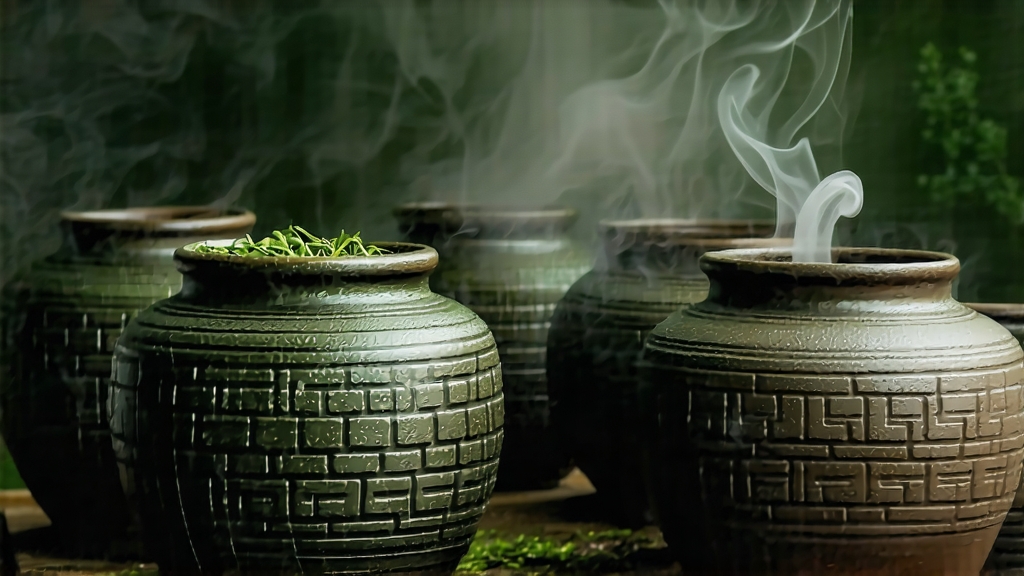
Tucked away in the subtropical mountains of southern China’s Guangxi Zhuang Autonomous Region, Liu Bao tea has spent four centuries quietly fermenting its way into the hearts of merchants, medicine men, and modern connoisseurs. To most outsiders “dark tea” evokes the mellow bricks of Yunnan’s Pu-erh, yet Liu Bao is the older, humbler sibling that once rode the same horse caravans, sailed the same junks, and cured the same dysentery along the ancient Tea Road to Southeast Asia. Today, as specialty cafés from Brooklyn to Berlin hunt for the next big post-pu-erh obsession, Liu Bao is stepping out of the bamboo baskets and into the spotlight.
A Brief, Muddy History
The name simply means “Six Forts,” a reference to the six defensive stockades that guarded the small county of Cangwu during the Ming dynasty. By the late 1500s the region had become a staging post for Yao, Hakka, and Zhuang minorities who bartered mountain-grown tea for salt and iron. Because the journey to Guangdong’s humid ports could take months, tea was compressed into 40 kg bamboo baskets and deliberately left in open-air warehouses where it absorbed ambient microbes. The accidental wet-storage created a mellow, medicinal liquor that cooled the body and settled the stomach—qualities prized by dockworkers in the sweltering Pearl River Delta. When the British opened Hong Kong in 1842, Liu Bao sailed south with coolies and opium, establishing a loyal following in Malaysian tin mines where laborers drank it to prevent malaria. By the 1950s Guangxi’s state tea corporations standardized the craft, coining the term “wet-piling” (wo dui) that Yunnan would later borrow for ripe Pu-erh.
From Leaf to Basket: The Making of Liu Bao
Liu Bao starts life as a workaday Camellia sinensis var. sinensis cultivar called “Zhongye zhong,” mid-sized leaves that tolerate shade and mist. Picking occurs from April to October; the later rainy-season harvests, once dismissed as inferior, are now coveted for their higher microbial load. After plucking, the leaves are carried in bamboo sieves to nearby factories where they undergo:
- Solar withering for two hours to reduce moisture to 65 %.
- Indoor piling for twelve hours to generate enzymatic heat.
- 200 °C pan-firing in 5 kg batches to kill greenness yet preserve leaf integrity.
- Rolling on twin-disk machines for 30 minutes to rupture cells without shredding.
- A second, gentler firing at 120 °C to drop moisture to 20 %—a crucial step that distinguishes Liu Bao from Pu-erh’s sun-dried maocha.
Now comes the signature act: wet-piling. The semi-dry leaves are sprayed with mountain spring water (never chlorinated), heaped 70 cm high on cement floors, and covered with jute sacks. Thermophilic bacteria and Aspergillus niger immediately bloom, driving the pile’s core to 55 °C within 24 hours. Every five days the pile is turned and re-sprayed; the entire sauna lasts 25–35 days depending on ambient humidity. When the leaf veins turn walnut-brown and emit a betel-nut sweetness, workers scatter the pile to cool, then re-fire at 80 °C to arrest fermentation. Finally the tea is steamed, compressed by foot into cylindrical bamboo baskets lined with wild banana leaf, and transferred to humid underground caves where it will age for a minimum of three years before release. Some state-owned factories still retain baskets from 1958; their leaves glisten with golden “tea cream,” a biofilm of yeasts that connoisseurs compare to the bloom on aged cheese.
Styles and Grades
Unlike Pu-erh’s mountain-village terroir obsession, Liu Bao is classified by age, basket size, and fermentation depth. The market recognizes three loose tiers:
• Young (1–5 years): mahogany liquor, notes of wet bark, sorghum, and a faint camphor bite.
• Middle (6–15 years): color shifts to ruby, the betel-nut note intensifies, and a cooling menthol finish appears.
• Old (16+ years): ink-black infusion, velvety body, aromas of ginseng, Chinese olive, and antique parchment.
Within each age band, leaf grade